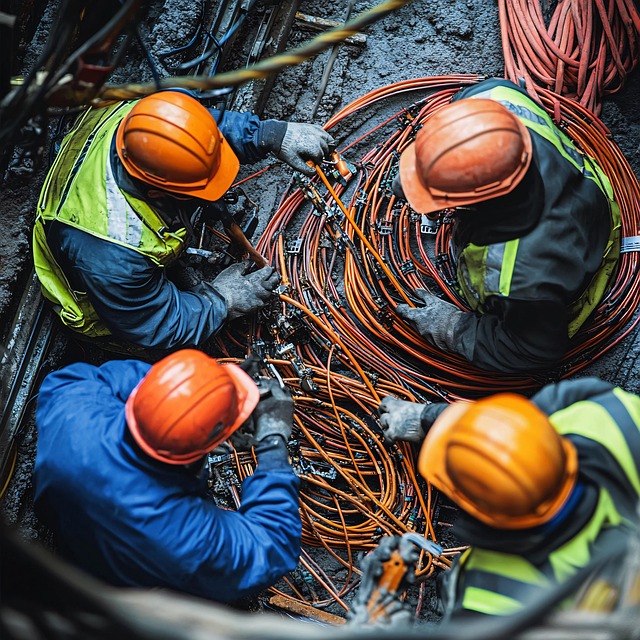Commercial structured cabling, encompassing CAT5e, CAT6, and CAT6a Ethernet cables, is a complex yet vital system for high-speed network installations. It includes cables, connectors, terminations, and hardware designed to support efficient data transmission within buildings and between them. Proper installation ensures data integrity, minimizes signal degradation, and facilitates future upgrades, with industry standards and best practices crucial for creating a robust network backbone. CAT6a stands out as a game-changer, offering up to 10 Gbps at 100 meters, ideal for demanding environments like data centers and enterprise networks. Best practices include proper termination, minimal bend radius, high-quality connectors, and adherence to industry standards for signal integrity and efficient data transfer, future-proofing networks.
In today’s digital era, reliable and high-speed networking is paramount for businesses. Understanding and implementing the right commercial structured cabling can significantly enhance operational efficiency. This article delves into the intricacies of CAT5e, CAT6, and CAT6a installations, focusing on optimal speed and performance. We explore the fundamental concepts of commercial structured cabling, dissect key differences between CAT5e and CAT6, uncover the advantages of CAT6a, and provide best practices for installation to ensure maximum reliability and speed in your network.
Understanding Commercial Structured Cabling: The Foundation for High-Speed Networks
Commercial structured cabling forms the very foundation of high-speed network installations, including those utilizing CAT5e, CAT6, and CAT6a Ethernet cables. It’s a complex yet vital system designed to support efficient data transmission within buildings and between them. This infrastructure includes not just the cables themselves but also the connectors, terminations, and hardware that enable reliable and fast connectivity.
Understanding commercial structured cabling involves recognizing its role in organizing and managing network systems. Properly installed cabling ensures data integrity, minimizes signal degradation, and allows for future upgrades without extensive restructuring. By adhering to industry standards and best practices, businesses can create a robust network backbone that supports today’s high-demand applications and prepares them for tomorrow’s technological advancements.
CAT5e vs CAT6: Key Differences and Applications in Structured Cabling
CAT5e and CAT6 are both popular choices for commercial structured cabling, but they have distinct characteristics that make them suitable for different applications. CAT5e (Category 5 Enhanced) is a well-established standard known for its reliability in transmitting data at speeds up to 1 Gbps (Gigabits per second). It’s commonly used for Ethernet connections and phone lines, making it ideal for smaller offices and residential settings where speed requirements are not excessively high. The cable features a solid copper conductor and a twisted-pair design that effectively minimizes interference.
On the other hand, CAT6 (Category 6) offers enhanced performance, supporting data transmission speeds up to 10 Gbps. This makes it a game-changer for demanding commercial structured cabling needs, such as large enterprises, data centers, and high-speed networks. CAT6 employs improved twisted-pair technology and shielding to reduce interference and crosstalk, ensuring reliable and fast connections. Its capability to handle higher speeds positions it as a future-proof option, especially with the ever-growing demands of modern networking infrastructure.
Unlocking Full Potential with CAT6a: Advantages and Best Practices
Unlocking the full potential of high-speed data transmission requires considering CAT6a as a game-changer in commercial structured cabling. This enhanced category cable offers significant advantages over its predecessors, CAT5e and CAT6, especially when it comes to speed and performance. With the ability to support up to 10 Gbps at lengths of up to 100 meters, CAT6a is ideal for demanding network environments, such as data centers and enterprise networks.
Best practices for CAT6a installation include ensuring proper termination and connectivity, maintaining minimal bend radius to preserve signal integrity, and using high-quality connectors and cables. Proper training and adherence to industry standards are essential to harnessing the full potential of this technology. By investing in reliable CAT6a infrastructure, businesses can future-proof their networks and unlock faster, more efficient data transfer, fostering a robust digital environment.
Installation Tips for Optimal Performance: Ensuring Speed and Reliability in Your Network
When installing CAT5e, CAT6, or CAT6a cables for optimal speed and performance in a commercial structured cabling system, attention to detail is paramount. Begin by selecting high-quality cables certified for your intended application, ensuring they meet or exceed industry standards. Proper cable management is crucial; organize and secure the cables along their route to prevent tangling or damage. Use appropriate connectors and terminations recommended by the manufacturer to maintain signal integrity.
For reliable performance, ensure a clean, dry installation environment free from potential sources of interference like electrical equipment or metal fixtures. Properly label each cable segment for easy troubleshooting and maintenance in the future. Regular testing during and after installation is essential using suitable test equipment to verify data transmission speed and identify any issues early on.
In the realm of commercial structured cabling, selecting the right cable standard is pivotal for achieving optimal network speed and reliability. By understanding the nuances between CAT5e, CAT6, and CAT6a, businesses can make informed decisions tailored to their high-speed requirements. Each generation offers enhanced performance capabilities, catering to evolving demands from data centers to bustling metropolises. Embracing best practices during installation, as outlined in this article, ensures that the chosen cable standard lives up to its full potential, thereby fostering a robust and efficient network infrastructure for years to come.
